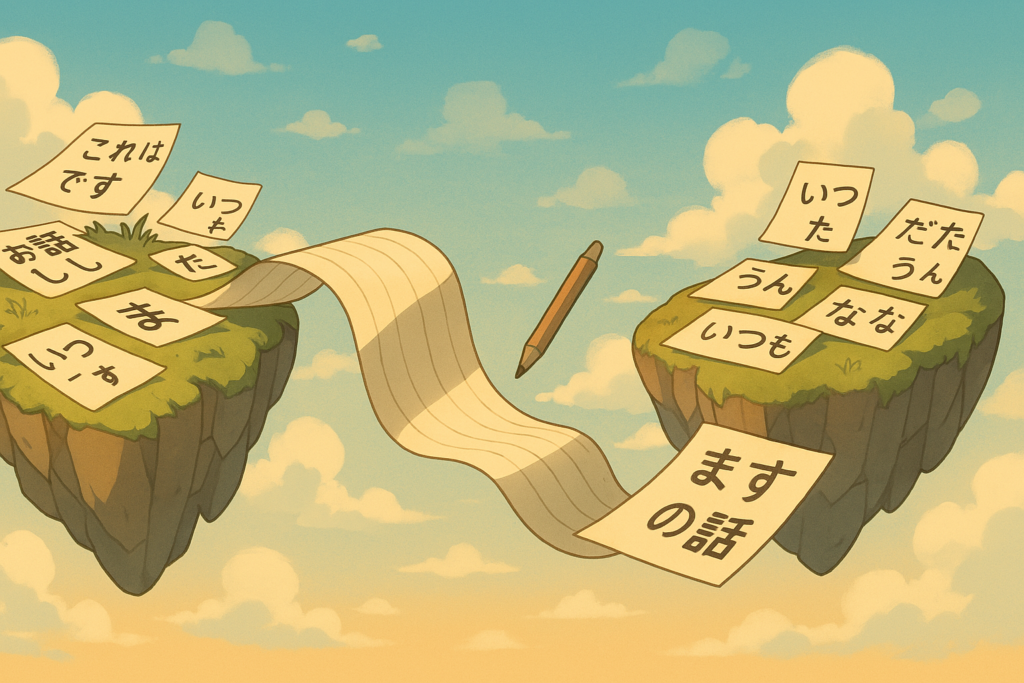Have you ever found yourself struggling to connect your thoughts when writing or speaking in Japanese? Those awkward pauses and disjointed sentences can make even the most brilliant ideas fall flat. Japanese transition words are the essential building blocks that transform choppy sentences into flowing, eloquent communication.
Learning to use Japanese transition words effectively isn’t just about sounding more natural—it’s about conveying your thoughts with precision and clarity. Whether you’re crafting an essay, preparing for the JLPT, or simply trying to have more natural conversations, mastering these connective phrases will dramatically improve your Japanese fluency.
In this comprehensive guide, we’ll explore the most useful Japanese transition words for every situation, provide authentic examples, and share practical tips to help you incorporate them naturally into your Japanese. By the end, you’ll have the confidence to express yourself more cohesively in both written and spoken Japanese.
Essential Categories of Japanese Transition Words
For Introducing Examples and Adding Emphasis
When you want to illustrate your point with examples or add emphasis to your statement, these Japanese transition words will come in handy:
| Japanese | Romaji | English Meaning |
|---|---|---|
| たとえば | tatoeba | for example |
| つまり | tsumari | that is, in other words |
| とくに | tokuni | especially |
| 実は (じつは) | jitsu wa | actually, in fact |
| 本当に (ほんとうに) | hontō ni | really, indeed |
Example in context: 日本語の勉強では、たとえば単語カードを使うのが効果的です。 Nihongo no benkyō dewa, tatoeba tango kādo wo tsukau no ga kōkateki desu. In Japanese study, for example, using vocabulary cards is effective.
For Explaining Reasons and Results
Connect cause and effect or explain your reasoning with these essential transition phrases:
| Japanese | Romaji | English Meaning |
|---|---|---|
| ために | tame ni | in order to, for the purpose of |
| だから | dakara | therefore, so |
| 〜のため | ~no tame | because of, due to |
| 〜というわけで | ~to iu wake de | for that reason |
| だって | datte | because, after all |
Example in context: 試験に合格するために、毎日日本語を勉強しています。 Shiken ni gōkaku suru tame ni, mainichi nihongo wo benkyō shiteimasu. In order to pass the exam, I study Japanese every day.
For Showing Sequence and Order
When explaining a process or listing items in order, these transition words help maintain a clear structure:
| Japanese | Romaji | English Meaning |
|---|---|---|
| 最初に (さいしょに) | saisho ni | first, initially |
| 次に (つぎに) | tsugi ni | next, then |
| その後 (そのあと) | sono ato | after that |
| 最後に (さいごに) | saigo ni | finally, lastly |
| まず | mazu | first of all |
Example in context: まず、材料を準備します。次に、調理を始めます。最後に、盛り付けをします。 Mazu, zairyō wo junbi shimasu. Tsugi ni, chōri wo hajimemasu. Saigo ni, moritsukewo shimasu. First, prepare the ingredients. Next, start cooking. Finally, plate the dish.
Advanced Japanese Transition Words for Sophisticated Writing
As you progress in your Japanese studies, incorporating more sophisticated transition words will elevate your writing style, as we explained in our previous post on understanding the wakatta meaning. Here are some advanced connectors:
For Adding Supporting Statements
| Japanese | Romaji | English Meaning |
|---|---|---|
| さらに | sara ni | furthermore, moreover |
| それに | sore ni | additionally |
| しかも | shikamo | what’s more, moreover |
| また | mata | also, in addition |
| それから | sore kara | and then, besides |
Example in context: この映画は面白いです。さらに、音楽も素晴らしいです。 Kono eiga wa omoshiroi desu. Sara ni, ongaku mo subarashii desu. This movie is interesting. Furthermore, the music is also wonderful.
Want to explore Japan’s culture?
Discover Japan’s rich culture, traditions, and hidden gems with our expertly crafted guides. Get insider tips on travel, food, and history. All for free!
For Demonstrating Contrast
Being able to express contrasting ideas is crucial for developing complex arguments, similar to how we discussed the concept of existence in our article about iru meaning in Japanese:
| Japanese | Romaji | English Meaning |
|---|---|---|
| しかし | shikashi | however, but |
| でも | demo | but, though |
| それにもかかわらず | sore ni mo kakawarazu | nevertheless, regardless |
| 〜とちがって | ~to chigatte | unlike, different from |
| 一方 (いっぽう) | ippō | on the other hand |
Example in context: 日本語の文法は難しいです。しかし、練習すれば上達します。 Nihongo no bunpō wa muzukashii desu. Shikashi, renshū sureba jōtatsu shimasu. Japanese grammar is difficult. However, if you practice, you will improve.
For Summarizing and Concluding
End your writing effectively with these conclusion markers:
| Japanese | Romaji | English Meaning |
|---|---|---|
| 結論として (けつろんとして) | ketsuron to shite | in conclusion |
| 要するに (ようするに) | yō suru ni | in summary, in short |
| このように | kono yō ni | thus, in this way |
| まとめると | matomeru to | to sum up |
| 結局 (けっきょく) | kekkyoku | after all, in the end |
Example in context: 要するに、毎日の練習が日本語上達の鍵です。 Yō suru ni, mainichi no renshū ga nihongo jōtatsu no kagi desu. In short, daily practice is the key to improving Japanese.
Tips for Using Japanese Transition Words Naturally
- Study in context: Rather than memorizing lists, observe how Japanese transition words are used in authentic materials like articles, books, or conversations.
- Start with basics: Master a few common transition words from each category before moving on to more advanced ones.
- Practice with sentence combining: Take two simple Japanese sentences and combine them using appropriate transition words.
- Identify patterns: Notice which transition words commonly appear in formal writing versus casual conversation.
- Create a personal cheat sheet: Build your own collection of transition phrases organized by function for quick reference.
For comprehensive Japanese language learning resources, be sure to check out our Learn Japanese page where you can download free guides to accelerate your progress.
Common Mistakes to Avoid with Japanese Transition Words
Even advanced learners sometimes struggle with the proper use of transition words. Here are some common pitfalls to watch out for:
- Overusing だから (dakara): While commonly used, relying too heavily on だから can make your Japanese sound repetitive and elementary.
- Mixing formal and casual transition words: Be consistent with your level of formality throughout your writing or speech.
- Incorrect placement: Unlike English, many Japanese transition words need to be placed at the beginning of a sentence or clause.
- Not accounting for nuance: Some Japanese transition words carry subtle differences in meaning that aren’t apparent in their English translations.
FAQ: Japanese Transition Words
What are the most essential Japanese transition words for beginners?
The most essential Japanese transition words for beginners are たとえば (tatoeba – for example), だから (dakara – therefore), しかし (shikashi – however), and また (mata – also). These cover the basic functions of providing examples, explaining reasons, showing contrast, and adding information.
How do transition words differ in formal and casual Japanese?
In formal Japanese, transition words like したがって (shitagatte – therefore) and ゆえに (yue ni – consequently) are preferred, while casual settings favor simpler forms like だから (dakara) and それで (sore de). The level of formality significantly affects which transition words are appropriate.
Can I use Japanese transition words at the beginning of sentences?
Yes, most Japanese transition words can be used at the beginning of sentences. In fact, transition words like しかし (shikashi – however) and また (mata – also) are commonly placed at the beginning to clearly signal the relationship between ideas.
Conclusion: Elevate Your Japanese with Transition Words
Japanese transition words are the secret ingredient that can transform your basic Japanese into natural, flowing communication. By incorporating these connective phrases into your writing and speaking, you’ll not only sound more authentic but also express your thoughts with greater precision and clarity.
Remember that mastering Japanese transition words takes practice and exposure. Try to incorporate at least one new transition word into your Japanese studies each week, and soon you’ll find yourself connecting ideas effortlessly.
Whether you’re writing essays, preparing for exams, or simply aiming to communicate more effectively in Japanese, these transition words will serve as valuable tools in your language learning journey.
Looking for more ways to enhance your Japanese? Explore our other helpful resources like our guides on hazukashii meaning and expressions for the end in Japanese.
What are your favorite Japanese transition words? Share your thoughts and questions in the comments below!
Looking to take your Japanese studies to the next level? Visit our Learn Japanese page today to access our comprehensive free guides and resources!
Love Japan? Stay in the Loop!
Get the best of Japan straight to your inbox: language, culture & travel insights!




